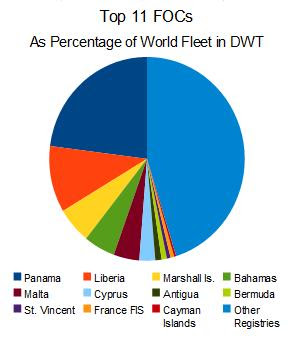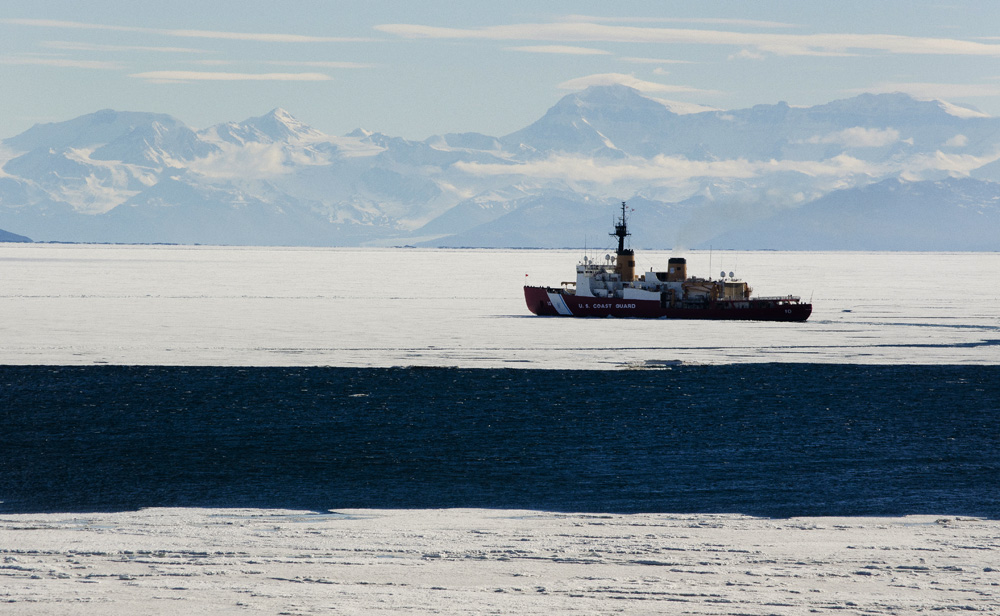Icebreaker Polar Star first U.S. Coast Guard ship to McMurdo since 2006-07, to reach the U.S. Antarctic Program's External U.S. government site largest research station through nine miles of sea ice on Jan. 16
[January 10]
USCG vessel 'Polar Star' The United States Coast Guard Cutter 'Polar Star' was released by the Australian Maritime Safety Authority from search and rescue duties this week, following confirmation the Russian-flagged 'Akademik Shokalskiy' and Chinese-flagged 'Xue Long ' were freed from the Antarctic ice
[January 5]
 |
| USCGC POLAR STAR (WAGB-10) in Sydney. |
Departing at 5am December 5 from Sydney US Coast Guard's Polar Star icebreaker will assist stranded Russian vessel, MV Akademik Shokalskiy, and ice-locked Chinese ship Xue Long. Coast Guard Pacific Area Command Center received the request January 2 from AMSA and determined there is sufficient concern that the vessels may not be able to free themselves from the ice
Polar Star is the US's only active polar-capable icebreaker and one of the world's most powerful non-nuclear ships, able to crack though 1.8m of ice while moving or more than 6m by ramming.
The ship was expected to take seven days to reach Commonwealth Bay, where the Chinese and Russian ships were stranded.
Class & type: Polar-class icebreaker
Displacement: 10,863 long tons (11,037 t) (standard) 13,623 long tons (13,842 t) (full)
Length: 399 ft (122 m)
Beam: 83 ft 6 in (25.45 m) Draft: 31 ft (9.4 m)[3]
Installed power: Six Alco 16V-251F diesel engines (6 × 3,000 hp) Three Pratt & Whitney FT-4A12 gas turbines (3 × 25,000 hp) Propulsion: Combined diesel-electric or gas (CODLOG) Three shafts; controllable pitch propellers Speed: 18 knots (33 km/h; 21 mph) 3 knots (5.6 km/h; 3.5 mph) in 6-foot (1.8 m) ice
Range: 16,000 nautical miles (30,000 km; 18,000 mi) at 18 knots (33 km/h; 21 mph) 28,275 nautical miles (52,365 km; 32,538 mi) at 13 knots (24 km/h; 15 mph)
Complement: 15 officers 127 enlisted 33 scientists 12-person helicopter detachment
Aircraft carried: 2 HH-65A Dolphin helicopters
Commissioned: 1976
[December 14]
A Chinese helicopter transferred all 52 passengers aboard a stranded Russian vessel to safe ice near an Australian rescue ship on January 2 10 days after the MV Akademik Shokalskiy became stuck in sea ice off Antarctica. The passengers, as well as luggage, scientific instruments and equipment, were flown to safe ice near the Aurora Australis by Xueying 12, a helicopter on board China's icebreaker Xuelong, and are aboard the Australian ship. An earlier flight examined the surrounding area to prepare for landing on ice.
[January 1]
The Xue Long is within about 18 kilometres of pack ice which is needed so it can operate its helicopter when the rescue begins. “[Captain Wang] has been sitting there because his helicopter doesn't have floats, so it can't fly over water.” But to avoid getting caught in the pack itself, the Xue Long has been slowly moving back towards open water, Captain Doyle said.
[December 31 2013]
 |
| Xue Long had a helicopter on board, it was too heavy for the Aurora's helideck. |
Or perhaps, When the rescue does occur, passengers will be transported via helicopter in groups of 12. The helicopter, Young said, will land on a makeshift helipad created on ice and shuttle back and forth. All 52 passengers will then be picked up by the Aurora Australis, which will then transport everyone to Hobart, Australia.
"It's now up to us three ships [the Shokalskiy, the Aurora and the Xue Long] to agree on a [rescue] strategy,"Aurora's captain, Murray Doyle said.
While the Xue Long had a helicopter on board, it was too heavy for the Aurora's helideck.
"We also can't use the helicopter at the moment because there is no visibility," he said.
"The helicopter wouldn't be able to differentiate the horizon from the ice."
The Xue Long, which has been waiting near the Mertz Glacier since Boxing Day, was also making its way back to open water.
"They're trying to make it back into open water so they're not trapped as well," Captain Doyle said.
Captain Doyle also feared that the 55-kilometre south-easterly wind running up the ship's stern would blow ice in and around the back of the vessel.
"It was pushing those same types of floes in behind us," he said.
"If we got into that compact stuff it would have sealed us in, we would have lost our manoeuvreability and we wouldn't have been much use to anybody.
"Having been caught in ice before, I know by experience when to get out. I didn't want to add to the drama, instead of being part of the solution," he said.
A low-hanging fog also hampered rescue efforts.
"We had no visibility so we couldn't really see if there was a way through."
Captain Doyle had informed the Rescue Co-ordination Centre in Canberra of the situation.
The passengers on the stranded Shokalskiy would most likely be evacuated to the Aurora or Chinese ice-breaker the Xue Long, which was also in the area.
Bad news: Aurora couldn't get through. Tried twice. Low visibility & heavy ice. Returning to open water. Try again tomorrow? #spiritofmawson
— Chris Turney (@ProfChrisTurney) December 30, 2013
[12/27]
A second rescue vessel, the French-flagged icebreaker L'Astrolabe, was released from the rescue operation yesterday.
Our rescue boat, the Xue Long, has had to turn back because the ice was too thick for it to get through. We're now awaiting Aurora Australis
— Alok Jha (@alokjha) December 27, 2013
The icebreakers en route are China’s Xue Long (Snow Dragon) from Fremantle, the French vessel Astrolabe and the Australian Antarctic Division vessel Aurora Australis.
Name: Xuě Lóng (雪龙) Port of registry: Shanghai, People's Republic of China
Builder: Kherson Shipyard, Ukraine
Completed: 25 September 1993
Refit: 2007
Identification: IMO number: 8877899
Call sign: BNSK
MMSI number: 412863000[1]
Status: In service
General characteristics
Type: Research vessel
Tonnage: 14,997 GT[1]
4,499 NT[2]
10,225 DWT[3][Note 1] Displacement: 21,025 tons Length: 167 m (548 ft) Beam: 22.6 m (74 ft) Draft: 9 m (30 ft) Ice class: CCS B1 Installed power: BMZ 8DKRN60/195 (13,200 kW) Propulsion: Single shaft, ducted controllable pitch propeller Speed: 18 knots (33 km/h; 21 mph) (max) 1.5 knots (2.8 km/h; 1.7 mph) in 1.1 m (3 ft 7 in) ice Range: 20,000 nautical miles (37,000 km; 23,000 mi)[3]
Complement: 34 crew, 128 passengers or researchers
Aircraft carried: One helicopter
Aviation facilities: Helipad
Early on December 25, Christmas morning, MV Akademic Shokalskiy, a tourist ship recreating Sir Douglas Mawson’s 100-year-old Australasian Antarctic Expedition, signalled it was stuck in heavy pack ice.
While ships often get surrounded by pack ice around Antarctica, the Russian Shokalskiy, a medium-sized vessel with about 74 crew and passengers, was in danger of being hit by a large iceberg.
Just before 5am the Rescue Co-ordination Centre, part of the Australian Maritime Safety Authority in Canberra, ordered three ships, a Chinese and French vessel and the Aurora Australis, to lend assistance.
Name: Akademik Shokalskiy
IMO: 8010336
Flag: Russia
MMSI: 273458210
Callsign: UBNF
Technical Data
Vessel type: Passengers Ship
Gross tonnage: 1,764 tons
Summer DWT: 620 tons
Length: 72 m
Beam: 12 m
Draught: 0.5 m
Additional Information
Home port: Vladivostok
Class society: Russian Maritime Shipping Register
Build year: 1982
Builder (*): Stx Finland Turku
Turku, Finland
Owner: Far Eastern Research Institute
Vladivostok, Russia
Manager: Far Eastern Research Institute
Vladivostok, Russia










No comments:
Post a Comment